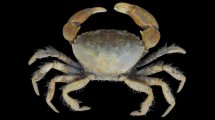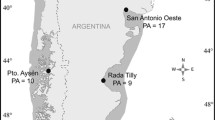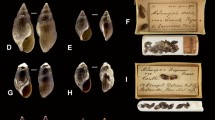Abstract
The genetic variability of the gonochoric Leptestheria dahalacensis (Rüppel, 1837) was studied through the analysis of mitochondrial and nuclear (microsatellite loci) markers in eight Italian and two Central European populations. Mitochondrial data exhibited a low variability, as only six mitotypes were scored: five in Italy and one for both Central European samples, with a very low number of substitutions. All analysed microsatellite loci were variable, with 3–5 alleles per locus and 1–4 alleles per population. All populations were at the Hardy–Weinberg equilibrium, with the exceptions of two samples for locus ldAC-16, due to heterozygote excess, and of four populations for locus ldAC-11, probably linked to the presence of null alleles. A substantial population structuring was found between Central European and Italian samples for both utilized markers. This observation may be explained by isolation by distance and/or recent isolation events. On the other hand, the absence of a clear inter-pond variability in Italian sample comparisons may be ascribed to high dispersal ability in the short range.




Similar content being viewed by others
References
Abreu-Grobois, F. A., 1987. A review of the genetics of Artemia. In Sorgeloos, P., D. A. Bengtson, W. Decleir & E. Jaspers (eds), Artemia research and its applications, Vol. 1 Universa, Wetteren, 61–99.
Belkhir, K., P. Borsa, L. Chikhi, N. Raufaste & F. Bonhomme, 1996–2004. GENETIX 4.05, logiciel sous Windows™ pour la génétique des populations. Laboratoire Génome, Populations, Interactions, CNRS UMR 5000, Université de Montpellier II, Montpellier (France). (code available at http://www.univ-montp2.fr/˜genetix/genetix/genetix.htm).
Boileau, M. G., P. D. N. Hebert & S. S. Schwartz, 1992. Nonequilibrium gene frequency divergence: persistent founder effects in natural populations. Journal of Evolutionary Biology 5: 25–39.
Braband, A., S. Richter, R. Hiesel & G. Scholtz, 2002. Phylogenetic relationships within the Phyllopoda (Crustacea, Branchiopoda) based on mitochondrial and nuclear markers. Molecular Phylogenetics and Evolution 25: 229–244.
Brendonck, L. & B. J. Riddoch, 1999. Wind-borne short-range egg dispersal in anostracans (Crustacea: Branchiopoda). Biological Journal of the Linnean Society 67: 87–95.
Brendonck, L., L. De Meester & B. J. Riddoch, 2000. Regional structuring of genetic variation in short-lived rock pool populations of Branchipodopsis wolfi (Crustacea: Anostraca). Oecologia 123: 506–515.
Chambers, G. K. & E. S. MacAvoy, 2000. Microsatellites: consensus and controversy. Comparative Biochemistry and Physiology Part B 126: 455–476.
Colautti, R. I., M. Manca, M. Viljanen, H. A. Ketelaars, H. Bürgi, H. J. Macisaac & D. D. Heath, 2005. Invasion genetics of the Eurasian spiny waterflea: evidence for bottlenecks and gene flow using microsatellites. Molecular Ecology 14: 1869–1879.
Corujo, M., G. Blanco, E. Vazquez & J. A. Sanchez, 2004. Genetic structure of northwestern Spanish brown trout (Salmo trutta L.) populations, differences between microsatellite and allozyme loci. Hereditas 141: 258–71.
De Meester, L., A. Gòmez, B. Okamura & K. Schweink, 2002. The Monopolization Hypothesis and the dispersal-gene flow paradox in aquatic organisms. Acta Oecologica 23: 121–135.
deWaard, J. R., V. Sacherova, M. E. A. Cristescu, E. A. Remigio, T. J. Crease & P. D. N. Hebert, 2006. Probing the relationships of the branchiopod crustaceans. Molecular Phylogenetics and Evolution 39: 491–502.
Doyle, J. J. & J. L. Doyle, 1987. A rapid DNA isolation method for small quantities of fresh tissues. Phytochemical Bulletin 19: 11–15.
Dumont, H. J. & S. V. Negrea, 2002. Introduction to the Class Branchiopoda. Backhuys Publishers, Leiden.
Ellegren, H., 2000. Microsatellites mutations in the germline: implications for evolutionary inference. Trends in Genetics 16: 551–558.
Folmer, O., M. Black, R. Hoeh, R. Lutz & R. Vrijenhoek, 1994. DNA primers for amplification of mitochondrial cytochrome c oxidase subunit I from diverse metazoan invertebrates. Molecular Marine Biology and Biotechnology 3: 294–299.
Figuerola, J. & A. J. Green, 2002. Dispersal of aquatic organisms by waterbirds: a review of past research and priorities for future studies. Freshwater Biology 47: 483–494.
Figuerola, J., A. J. Green & T. J. Michot, 2005. Invertebrate eggs can fly: evidence of waterfowl-mediated gene flow in aquatic invertebrates. American Naturalist, 165: 274–280.
Fryer, G., 1987. A new classification of the branchiopod Crustacea. Zoological Journal of the Linnean Society 91: 357–383.
Gòmez, A., G. J. Adcock, D. H. Lunt & G. R. Carvalho, 2002. The interplay between colonization history and gene flow in passively dispersing zooplankton: microsatellite analysis of rotifer egg banks. Journal of Evolutionary Biology 15: 158–171.
Goudet, J., 2001. FSTAT, a program to estimate and test gene diversities and fixation indices (version 2.9.3). (code available from http://www.unil.ch/ izea/softwares/fstat.html).
Hanner, R. & M. Fugate, 1997. Branchiopod phylogenetic reconstruction from 12S rDNA sequence data. Journal of Crustacean Biology: 17: 174–183.
Hewitt, G. M., 1996. Some genetic conseguences of ice ages, and their role in divergence and speciation. Biological Journal of the Linnean Society 58: 247–276.
Hoeh, W. R., N. D. Smallwood, D. M. Senyo, E. G. Chapman & S. C. Weeks, 2006. Evaluating the monophyly of Eulimnadia and the Limnadiinae (Branchiopoda: Spinicaudata) using DNA sequences. Journal of Crustacean Biology 26: 182–192.
King, J. L. & R. Hanner, 1998. Cryptic species in a “living fossil” lineage: taxonomic and phylogenetic relationships within the genus Lepidurus (Crustacea: Notostraca) in North America. Molecular Phylogenetics and Evolution 10: 23–36.
Korn, M., F. Marrone, J. L. Pérez-Bote, M. Machado, M. Cristo, L. Cancela da Fonseca & A. K. Hundsdoerfer, 2006. Sister species within the Triops cancriformis lineage (Crustacea, Notostraca). Zoologica Scripta 35: 301–322.
Korn, M. & A. K. Hundsdoerfer, 2006. Evidence for cryptic species in the tadpole shrimp Triops granarius (Lucas, 1864) (Crustacea: Notostraca). Zootaxa 1257: 57–68.
Kumar, S., K. Tamura & M. Nei, 2004. MEGA3: Integrated software for Molecular Evolutionary Genetics Analysis and sequence alignment. Briefings in Bioinformatics 5: 150–163.
Li, Y., A. B. Korol, T. Fahima, A. Beiles & E. Nevo, 2002. Microsatellites: genomic distribution, putative functions and mutational mechanisms: a review. Molecular Ecology 11: 2453–2465.
Limburg, P. A. & L. J. Weider, 2002. ‘Ancient’ DNA in the resting egg bank of a microcrustacean can serve as a palaeolimnological database. Proceedings of the Royal Society of London. Series B: Biological Sciences 269: 281–7.
Luchetti, A., A. Marino, F. Scanabissi & B. Mantovani, 2004. Genomic dynamics of a low copy number satellite DNA family in Leptestheria dahalacensis (Crustacea, Branchiopoda, Conchostraca). Gene 342: 313–320.
Mantovani, B., M. Cesari & F. Scanabissi, 2004. Molecular taxonomy and phylogeny of the ‘living fossil’ lineages Triops and Lepidurus (Branchiopoda: Notostraca). Zoologica Scripta 33: 367–374.
Martin, J. W., 1992. Branchiopoda. In Microscopy Anatomy of Invertebrates, Vol. 9: Crustacea. Wiley-Liss, Inc., 25–224.
Murugan, G., A. M. Maeda-Martinez, H. Obregòn-Barboza & N. Y. Hernandez-Saavedra, 2002. Molecular characterization of the tadpole shrimp Triops (Branchiopoda: Notostraca) from the Baja California peninsula, México: new insights on species diversity and phylogeny of te genus. Hydrobiologia 486: 101–113.
Nei, M., F. Tajima & Y. Tateno, 1983. Accuracy of estimated phylogenetic trees from molecular data. II. Gene frequency data. Journal of Molecular Evolution 19: 153–170.
Nybom, H., 2004. Comparison of different nuclear DNA markers for estimating intraspecific genetic diversity in plants. Molecular Ecology 13: 1143–1165.
Paetkau, D., W. Calvert, I. Stirling & C. Strobeck, 1995. Microsatellite analysis of population structure in Canadian polar bears. Molecular Ecology 4: 347–354.
Pálsson, S., 2000. Microsatellite variation in Daphnia pulex from both sides of the Baltic Sea. Molecular Ecology 9: 1075–1088.
Piry, S., A. Alapetite, J. M. Cornuet, D. Paetkau, L. Baudouin & A. Estoup, 2004. GeneClass2: A Software for Genetic Assignment and First-Generation Migrant Detection. Journal of Heredity 95: 536–539.
Pfrender, M. E., K. Spitze & N. Lehman, 2000. Multi-locus genetic evidence for rapid ecologically based speciation in Daphnia. Molecular Ecology 9: 1717–1735.
Raymond, M. & F. Rousset, 1995. GENEPOP (version 1.2): population genetics software for exact tests and ecumenicism. Journal of Heredity 86: 248–249.
Reece, K. S., W. L. Ribeiro, P. M. Gaffney, R. B. Carnegie & S. K. Allen Jr., 2004. Microsatellite marker development and analysis in the Eastern Oyster (Crassostrea virginica): confirmation of null alleles and non-Mendelian segregation ratios. Journal of Heredity 95(4): 346–352.
Rozen, S. & H. J. Skaletsky, 2000. Primer3 on the WWW for general users and for biologist programmers. In Krawetz, S. & S. Misener (eds), Bioinformatics Methods and Protocols: Methods in Molecular Biology. Humana Press, Totowa, NJ, 365–386. (Code available at http://www-genome.wi.mit.edu/genome_software/other/primer3.html).
Sambrook, J., E. T. Fritsch & T. Maniatis, 1989. Molecular cloning. A laboratory manual. Cold Spring Harbor Laboratory, Cold Spring Harbor, NY.
Simon, C., F. Frati, A. Beckenbach, B. Crespi, H. Liu & P. Flook, 1994. Evolution weighting and phylogenetic utility of mitochondrial gene sequences and a compilation of conserved polymerase chain reaction primers. Annals of the Entomological Society of America 87: 651–701.
Stenderup, J. T., J. Olesen & H. Glenner, 2006. Molecular phylogeny of the Branchiopoda (Crustacea)–Multiple approaches suggest a ‘diplostracan’ ancestry of the Notostraca. Molecular Phylogenetics and Evolution 41: 182–194.
Thiéry, A. & D. Pont, 1987. Eoleptestheria ticinensis (Balsamo-Crivelli, 1859) Conchostracé nouveau pour la France (Crustacea, Branchiopoda, Conchostraca). Vie et Milieu 37: 115–121.
Tinti, F. & F. Scanabissi, 1996. Reproduction and genetic variation in clam shrimps (Crustacea, Branchiopoda, Conchostraca). Canadian Journal of Zoology 74: 824–832.
Van Oosterhout, C., W. F. Hutchinson, D. P. M. Wills & P. Shipley, 2004. Micro-Checker: software for identifying and correcting genotyping errors in microsatellite data. Molecular Ecology Notes 4: 535–538.
Weeks, S. C. & R. J. Duff, 2002. A genetic comparison of different populations of clam shrimp in the genus Eulimnadia. Hydrobiologia 486: 295–302.
Wirth, T. & L. Bernatchez, 2001. Genetic evidence against panmixia in the European eel. Nature 409: 1037–1040.
Wright, S., 1969. Evolution and the Genetics of Populations, Vol. 2: The Theory of Gene Frequencies. University of Chicago Press, Chicago, 511 pp.
Zane, L., L. Bargelloni & T. Patarnello, 2002. Strategies for microsatellite isolation: a review. Molecular Ecology 11: 1–16.
Acknowledgements
We wish to thank E. Eder and I. Frolova for supplying the Austrian and German specimens, respectively. This work was supported by M.U.R.S.T. 40% funds.
Author information
Authors and Affiliations
Corresponding author
Additional information
Handling editor: K. Martens
Rights and permissions
About this article
Cite this article
Cesari, M., Luchetti, A., Scanabissi, F. et al. Genetic variability in European Leptestheria dahalacensis (Rüppel, 1837) (Crustacea, Branchiopoda, Spinicaudata). Hydrobiologia 586, 249–260 (2007). https://doi.org/10.1007/s10750-007-0645-2
Received:
Revised:
Accepted:
Published:
Issue Date:
DOI: https://doi.org/10.1007/s10750-007-0645-2




